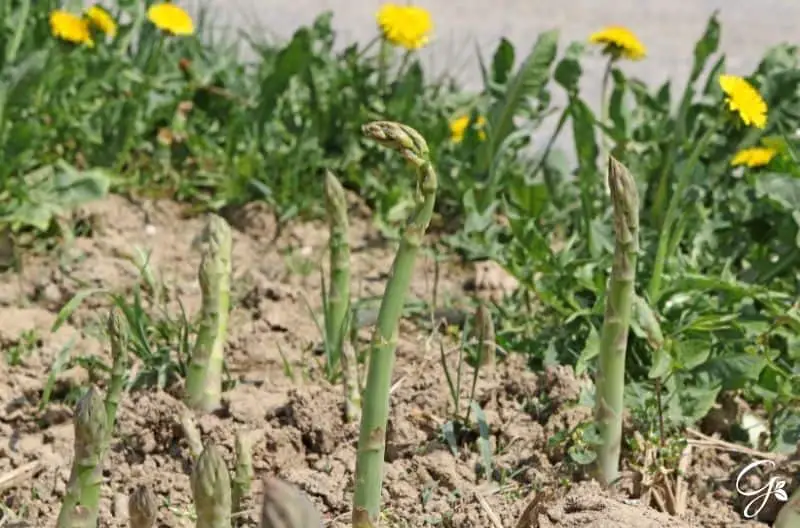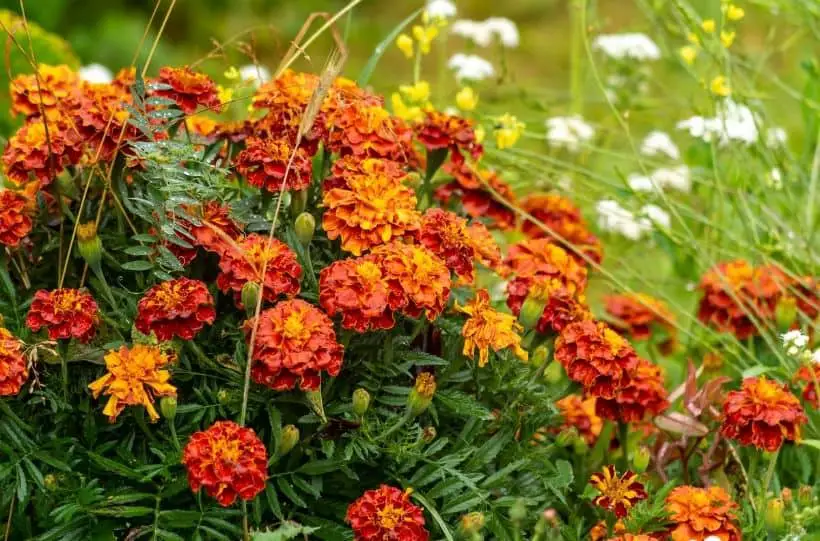7 Best Asparagus Companion Plants
Companion planting is an age-old strategy gardeners use to maximise their available space. It is a good method to setting up your garden with crops planted systematically to offer mutual benefits and limit the risk of pests and disease.
Taking extra time to plan and arrange your garden properly, can reap rewards for years to come, especially when it comes to planting perennial crops such as asparagus.
Asparagus is just one of many crops that makes a suitable companion plant. But, like most crops, certain plants work well with asparagus, and plants you should avoid completely.
Take a look at this list of asparagus companion plants so you know exactly what works well with your asparagus, along with which plants to avoid.

7 Best Asparagus Companion Plants
Here are 7 of the best asparagus companion plants that won’t damage or compete with your asparagus. Likewise, your asparagus plant works well with each of these crops and will grow well when planted together.
Tomatoes
If you only have space for one companion plant, tomatoes would be the best choice. They work well planted with asparagus as they help to deter asparagus beetles.
Tomatoes release a chemical called solanine, which asparagus beetles detest, helping to keep your asparagus plants clean and pest free.
In return, asparagus plants also emit a chemical that is disliked by nematodes. Nematodes are renowned for destroying full tomato crops. When planted together, both plants help repel the other crops’ pests, without competing for space.
Marigolds and Nasturtiums
Brilliant yellows and oranges, these flowers are not only beneficial for deterring pests, but also make a colourful addition to your vegetable garden.

Planted together, these flowers have an important job to do. Marigolds are excellent at deterring a range of pests such as whiteflies, aphids, and nematodes. Whilst nasturtiums help distract pests away from crops, by offering a food barrier between your pests and crops. When planted around your crops, they help attract pests to feed on them instead of feeding on your asparagus.
Working together, they provide a very powerful and natural pest barrier, helping your crops to thrive. Not to mention, their bright flowers help to attract beneficial pollinators to your crops.
Strawberries
Strawberries make excellent companion plants for asparagus as they do not directly compete with one another, but maximise the use of space.
Asparagus plants are usually planted in rows with wide gaps between each row. This is wasted space if not utilized, which is where your strawberry plants come in.

Strawberries have a shorter root system than asparagus plants and can be grown in the space between your asparagus rows. As they grow, they provide ground cover and shade for your asparagus plants and hence help to prevent weeds from growing too.
The great news is that strawberries are perennial plants. So once planted, with the right care in place, they will offer the same continued support each year.
Low-Level Leaves
Low-growing leaf crops such as lettuce and spinach are very beneficial for planting near asparagus.
They don’t have a deep root system and so don’t compete with asparagus for nutrients. As they grow, they work similarly to strawberries in keeping the ground covered and protecting asparagus roots.
However, spinach and lettuce do not always grow well in full, direct sunlight. So in return, asparagus plants help to provide shade over the leaves and keep them cooler.
Rhubarb
Before considering planting rhubarb you should consider if you have any pets and whether they can gain access to your vegetable garden. Rhubarb leaves contain a chemical known as oxalic acid which is very dangerous when eaten, so could be deadly if you have pets.
If you don’t have pets or they cannot access your vegetable garden, planting rhubarb can do wonders for your asparagus.
Rhubarb helps repel insects from your asparagus plants and is also effective at repelling insects that would otherwise eat your leafy crops e.g. lettuce.
Rhubarb does require quite a bit of space to grow, however, so ensure to plant it near, but not too close to your asparagus plants. Here, it can act as a pest deterrent without directly competing for space and nutrients with other crops.
What Not to Plant Next To Asparagus
With all companion plants, there are specific crops that should under no circumstances be planted next to one another. This could be for various reasons, but most are due to
- easily spreading diseases from one plant to another,
- being susceptible to the same pests,
- Competing for space and resources,
- Or stunting another crop’s growth.
Here are two types of plants that you should not plant next to asparagus:
Alliums
The allium family includes crops such as onions, garlic, shallots, leeks, and chives. Alliums require a lot of nutrients to grow over their long growing period. Due to this, they directly compete with other crops planted nearby. This can cause your asparagus to be stunted in growth and not reach its full potential.
Potatoes
Unlike alliums, the relationship between potatoes and asparagus is the opposite. Asparagus and potatoes’ roots grow at the same level and will grow wide as well as deep. Once again this introduces direct competition between crops and, in this instance, asparagus wins resulting in stunting the growth of your potato plants.
Like all crops, time should be spent planning your vegetable patch to ensure crops planted near one another benefit each other and do not have any negative impacts. Asparagus companion plants work well to repel pests, supporting the growth of your asparagus. In turn, as asparagus grows, it can provide essential shelter and shade for lower-level vegetables.
Make sure to follow this guide and our other companion planting guides so you know which crops work well together, and which crop combinations should be avoided.
For more companion planting tips, take a look at some of our additional gardening posts here:

